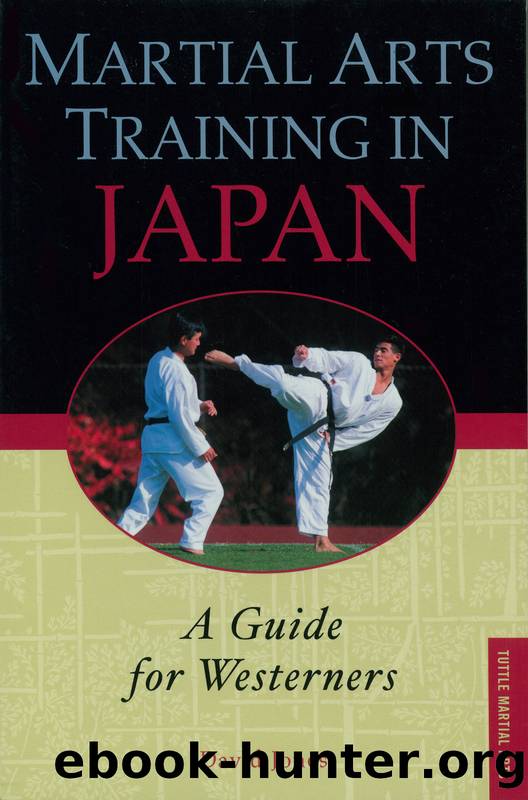Martial Arts Training in Japan by David Jones

Author:David Jones
Language: eng
Format: epub
ISBN: 0-8048-3270-6
Publisher: Tuttle Publishing
Bushido has no Bible, no Koran, no singular âHoly Book of Bushidoâ to which all may turn for instruction. Rather, it is a code of behavior bequeathed to the members of the Japanese warrior class over many centuries through the example of seniors and teachers, constant exhortations to lead a brave, honorable, and moral life, and through poems, songs, and various works of art. Nitobeâs reading of bushido is relatively modern. Earlier works like the Hagakure (Hidden in the Leaves), however, reflect the basic model of knightly behavior outlined by Nitobe as a code of internally consistent virtues.
The framework of bushido was firmly etched during the early education of the samurai youth, both male and female. The goal of education was to build stalwart character, and it was said to be built upon three principles: chi (wisdom), jin (benevolence), and yu (courage). Emphasis was placed on literacy, at least a nodding acquaintance with some of the Chinese (particularly Confucian) classics, and the ability to wield the writing brush with skill and spirit. Specific curricula included everything from literature, history, calligraphy, ethics, and military strategy and tactics to weapons practice, with a special focus on fencing, archery, spear fighting, horsemanship, and empty-handed self-defense. Various noble clans also had many secret techniques and curricula which they guarded for their own use and enrichment.
The sword, capable of cutting through gun barrels, was the ultimate weapon during its time, but it was much more than that. It was seen as a living thing, with a name, a personality, a particular history. It could be insulted, an act that would be taken as a personal insult by the samurai owning the weapon. Its spirit could be invoked for protection during sickness, childbirth, and times of grave danger. Its bright sheen, elegant shape, deadly potential, and beauty were seen as a model for samurai life. There was (and still is) an elaborate system of etiquette involved in handling swords, cleaning them, passing them from one person to another, and inspecting the blade of one belonging to someone else. The sword was a symbol of rank and prerogative. It was a work of art. It was a creation shared by the swordmaker and the gods. And yet it was rarely employed. In fact, the highest ideals of sword behavior were captured in such sayings as âThe best won victory is that obtained without shedding bloodâ and âA sword in the scabbard is a jewel of great price.â
One of the most objectionable aspects of bushido to the Westerner is the custom of seppuku (ritual disembowelment). Often erroneously called harakiri (literally, âbelly cuttingâ), seppuku was a legal ceremonial institution for the samurai used particularly to protest breaches of honor. When oneâs honor was irretrievably destroyed, the samurai believed that the taking of oneâs own life was justified. Sometimes seppuku was preceded by kataki uchi, or revenge against a person or persons believed to be responsible for the lethal assault on oneâs honor. The very high value placed on honor was the typical background cause of the act of ritual suicide.
Download
This site does not store any files on its server. We only index and link to content provided by other sites. Please contact the content providers to delete copyright contents if any and email us, we'll remove relevant links or contents immediately.
Shoe Dog by Phil Knight(4894)
The Rules Do Not Apply by Ariel Levy(4526)
Walking by Henry David Thoreau(3685)
Running Barefoot by Amy Harmon(3338)
I'll Give You the Sun by Jandy Nelson(3274)
How to Read Water: Clues and Patterns from Puddles to the Sea (Natural Navigation) by Tristan Gooley(3241)
Crazy Is My Superpower by A.J. Mendez Brooks(3207)
How to Read Nature by Tristan Gooley(3081)
How Music Works by David Byrne(2965)
The Boy, the Mole, the Fox and the Horse by Charlie Mackesy(2829)
The Fight by Norman Mailer(2707)
Seducing Cinderella by Gina L. Maxwell(2546)
Cuba by Lonely Planet(2490)
Accepted by Pat Patterson(2219)
Going Long by Editors of Runner's World(2214)
The Unfettered Mind: Writings from a Zen Master to a Master Swordsman by Takuan Soho(2159)
The Happy Runner by David Roche(2124)
Backpacker the Complete Guide to Backpacking by Backpacker Magazine(2111)
Trail Magic by Trevelyan Quest Edwards & Hazel Edwards(2063)
